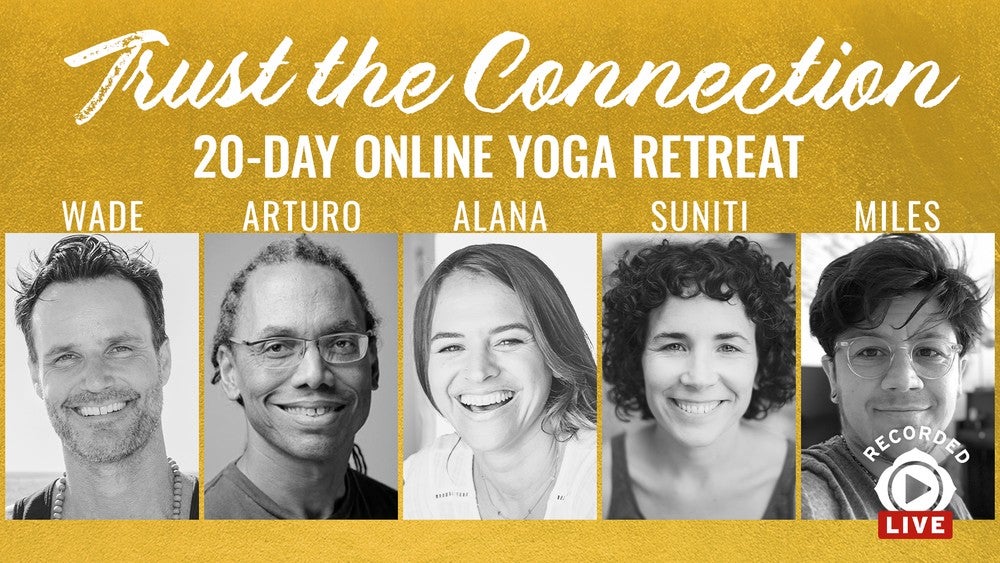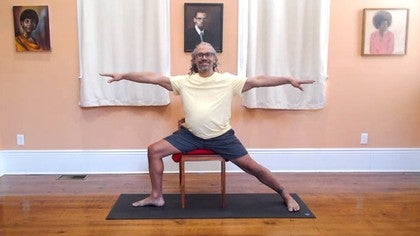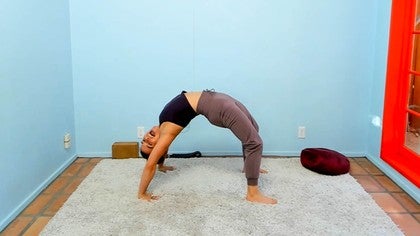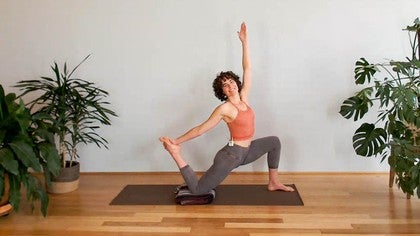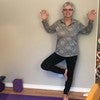Description
About This Video
Transcript
Read Full Transcript
Hi, everyone, and welcome to day 12 of Trust the Connection, our online retreat. My name is Arturo Piel, and I'm here in beautiful New Orleans, and really glad to have you. If you're just joining us, you're going to want to get a chair, and hopefully a chair without arm rests that are in the way so you're able to take your legs out to the sides, two blankets, and a block if you have them. And actually for this chair, I need a little cushy for my tushy, so I'm going to bring one of the blankets up, oh, that's better, one blanket up for my behind. So in the chair, let's start off not leaning back but sitting about the middle of the chair, feet planted firmly and a little bit wide.
And I want to be a little bit forward so I have room to round my back backwards. Hands on the knees, kind of like you're palming a basketball. You want your hands to be a little sticky. And we're going to start here with seated cat cow. So let's start by inhaling.
As you inhale, tip the tailbone back so you're sticking your booty out slightly, arching the back, looking slightly up. As you exhale, tuck the tailbone under and start to look down, letting the back of the spine round towards the space behind you. As you inhale, start to tilt your tailbone back behind you, sticking the booty out, opening the front of the spine, looking up slightly. As you exhale, leaning into the support of your hands on your knees, rounding, opening the backside of the spine and following the rhythm of your breath. If you notice you're going really fast, back and forth, try slowing your breath down and letting your breath lead the movement.
I really enjoy having the breath. The breath is kind of like the conductor of the orchestra and the body is the orchestra and the movement is the music. So the breath is leading us through at its own rhythm. As we make this smooth wave go through our spine, from the tailbone up to the top of the head. And the next time you inhale, lifting and opening the heart, then exhale, come to neutral.
And now we're going to take the middle of the back, so kind of like the low ribs and we're going to shift them a little over to one side and then shift them forward. So right now I'm sticking my booty out a bit and then shift them to the other side and then shift them back. So I'm going to make basically a circular movement with my torso. My head is going to stay fairly still, not completely still, but I want to get this circular... This movement feels like it reminds me of those bottle brushes at the sink.
I'm using this part of the movement like if I was sticking a bottle brush in and trying to rub the sides, the insides of my torso with the movement. I can coordinate this with the breath. As I'm here, it's exhaling, as I start to come to the side and forward, I'm going to inhale, exhale as I go to a side and back. And there's no race, there's no rush. You might find a spot that all feels good and you want to breathe and moan and groan.
A couple more laps here. And the next time you come to the back part at the center, inhale your way up to sitting up tall and then take the ribs to the other side and go the other direction. So that time I was going counterclockwise, now I'm going to go clockwise with my ribs. Notice if you're trying to help this movement with your jaw, let your jaw be soft, that these little muscles in between your brow be soft. My favorite muscle name is that little muscle, the corrugator supercilii.
I like it because it corrugates the forehead and it's a super silly thing to do most of the time. So you can inhale as you're on your way forward, exhale as you're on your way back. Now I'm trying to clean out the insides of your bottle with your movement. You can let your head get a little involved if you like. There's not a lot of really set rules with this other than go as slow as feels yummy, go as big or as small as feels good.
Moan and groan all you want. You can hang out at a spot if it feels right. I know some of us are hesitant to moan and groan in yoga class, but hey, you're by yourself or you're with a friend. Go for it. When I go to yoga classes, I'm the groaner in the back of class and I just don't care.
I really just don't care if people think I'm weird because they're right. One more orbit. And this time as you come to the front and center, return to neutral and take a pause, take a few breaths and let your head just kind of bobble and float, your jaw relax. We're going to do a little neck release here. So I'm going to take my right fingers and find a place on the chair where I can just hook the fingers.
And it might be challenging if the chair doesn't have that design. You can just hook your fingers under your thigh or hook them on the backside of your knee anywhere that feels good. I'm just going to hook them there and I'm going to let that arm relax except for the finger hook and then slowly side bend away from that hooked finger. Only going as far as feels really yummy. Check in with your breathing.
If your breathing constricts, back off a little bit, find the ease in the pose. And you can start to explore, try taking your chin a little towards your chest. You're going to get into a different angle along that neck and shoulder. Try tipping the nose slightly up, relaxing the jaw some more, breathing some more. And then coming back to center with the head, gradually sitting up and releasing your hands to your legs and just take a pause and notice if that side of your neck feels a little more floaty, a little more open.
We're going to take the other hand, the left hand, hook it on the chair or the leg, whatever works for you or under your booty, relax the shoulder and arm as much as you can while keeping the fingers hooked as you tip the head away. Notice if you're staring at the screen, sometimes it can be really helpful to just let the eyes go a little hazy or even close the eyes so that you can go into the sensations more. Relaxing the corrugator super silly eye between your eyebrows, relaxing the jaw, letting the chin drop a little towards your chest. It may be a little different than it was on the other side because humans are not symmetrical. No matter what the drawings in the anatomy books show us, you can slowly start to tilt the nose a little up.
Humans are asymmetrical. We have a dominant side, we tend to stand on one leg, bear weight on one side and twist in one side. All that changes our structure so we're a little asymmetrical. And depending on what you do, you may be more than a little asymmetrical. That's okay.
Asymmetry isn't the thing for me as an anatomy nerd. My thing is I love that the human body can find balance within asymmetry. Bringing that balance is a practice, a hobby, bringing the head back towards neutral and slowly coming back up straight and rest the hands and take a few breaths. Pull the head a little bit. Relax the jaw.
We're going to do something about relaxing the jaw because it's really easy to say relax the jaw but really hard to find how to do that. So we're going to do it seated and then we're going to do it on the ground right before Shavasana. So we're going to do it with our hands and we're going to use the flats of the fingers along the side of the jaw just below the cheekbone. Not fingertips. So imagine you have really long nails.
You don't want to give yourself acupuncture. Flats the fingers with the fingers pointing up and I'm going to try to sneak in here under my mic and just below the cheekbones. Now before you apply pressure, relax your shoulders, barely, barely touch your face. And the amount of pressure you're going to apply is about the weight of a couple of nickels. So about five to 10 grams.
The pressure is going to just go medially, equally towards your midline, towards your centerline. So it's not a lot of pressure. You're just energetically connecting your fingers to your jawbone. I like to use the image like my finger bones have an affinity. They have a magnetism to the jawbone and I'm just letting them connect to each other.
Just melting my finger pads towards my jawbone and you can let your jaw relax. You may notice your jaw wanting to relax already. You may notice your body wanting to take a few deep breaths. We sink into that connection. That's the first part of the jaw release and we keep that connection.
We don't change much. All we're going to change is adding a little tiny bit of weight to our elbows and again, it's only about five or 10 grams. Our elbows getting slightly heavy and tractioning the jaw slightly down. Almost immediately there's a tissue resistance. These muscles really hold all day, all night long and you don't want to push through that resistance.
And we're not massaging, just resting and connecting the finger pads. But letting, leaning into that little resistance and letting it melt at its own rhythm. The rhythm of the fascia release and the fascia, the connective tissue release has a tempo that kind of matches the movement of a glacier. It's very, very slow, very gradual. As you gently traction down, you might start to feel this gummy sensation just in front of your ear hole.
It might go up to the sides of your head. Try to let your shoulders stay relaxed. Eyes can close. Not a lot to watch here, just melting. And as the jaw melts, you may feel it want to twitch a little side to side.
That's okay. That's just the jaw, the body unwinding tension. And now we're going to keep the hands where they are, but release that magnetism and just let the hands gradually slide down off the face. Letting the jaw stay relaxed as the hands slide down off the face and come to rest on your legs. That's a great thing to practice when you're maybe having trouble sleeping.
It can be very, very relaxing. Okay, we're going to come into a little movement on the chair. Feet parallel, going straight ahead. Bring your arms and hands in front of your heart. We're going to do a little vinyasa flow here.
Exhale. As you inhale, sweep your hands out and up. And I'm modifying because my elbow's a little, my arm's a little injured. As you exhale, come forward into a forward fold. Release your head and neck.
Inhale, come halfway up, a flat back, looking down at the floor. As you exhale, release forward. As you inhale, sweep your hands out and up, I'm bending my elbows to reduce the weight in my shoulders. And exhale, your palms back to the heart, samastitihi. Do that a few times.
Inhale, sweep the hands up, exhale, coming forward into your forward fold. Release the head and neck. Inhale, come halfway up. Exhale, releasing forward. As you inhale, sweeping your arms out and up.
Exhale, returning to the beginning. Inhaling, sweeping up. Releasing forward. Inhale, halfway up, back flat. Exhale, releasing forward.
Inhale, sweeping the hands up, or the elbows up. Exhale, coming back, palms in front of the heart. From here, we're going to step the left leg out and the right leg back. Turning our center just a little on the diagonal, we're coming into warrior two legs. So some of us are going to want to stay here with the booty resting on the chair.
Some of you might be feeling sparky today and might want to lift your hips up off the chair. That's fine. You're the one inside your body you get to choose. Find your warrior two legs. Get really strong and steady in the legs.
Even if your booty is on the chair, still use your legs and your feet really connect to the floor and then float your arms to your warrior two spot. Might be straight out from the shoulders, or if that doesn't feel good for your shoulders and neck, it might be a little lower. And breathe. We're going to stay here a few more breaths. Inhale.
As you exhale, tip forward and bring your elbow to the front thigh. The back hand can reach up to the sky or past the ear. Since I have an injury on the other side, I'm going to do the same thing on both sides. I'm going to keep my hand down here to make it easier on my shoulder. And three breaths here.
Again, you might be all the way up out of the chair. You might have just a few ounces of your weight in the chair. Next inhale, sweep that right hand back. Reach it back to pull you up and exhale into reverse warrior's back hand. The right hand can come to the leg.
The front hand can reach towards the sky or reach the elbow towards the sky. Now I need to find where it doesn't hurt, and that's where it is for me today. Still breathing, listening to your body. So if this is your yummy spot, getting that lengthening through your whole left side, then you get yourself yummy. Next inhale coming back up to warrior two, exhale, releasing the arms down, jumping the legs together.
Coming back to the beginning, you don't have to jump really. And then we're going to step the right leg out to the side. Step the left leg back, coming into warrior two legs. And I have to find my spot on the chair, it's a little tricky sometimes. Warrior changes once you pass 60.
Ah, there we go, there we go, there we go, okay, and then find your spot for your arms. I'm going to keep my arms the same on this side. So whatever your warrior two is, find it, rock it, weight can be in the chair or maybe out of the chair or maybe half supported. Wherever you are, breathing, relaxing the shoulders, reaching through the finger pads and fingertips, and enjoying your warrior two. Keep lengthening your spine, power in your feet, inhale, as you exhale we're going to tip forward, bringing the front hand or elbow to the leg and taking the back arm and reaching it up or the elbow up or down along the side.
That's what my shoulder needs today, finding your pose and finding your head position. You may keep your eyes and nose facing forward, you may want to look down, you may want to look up, the weight of my hair makes me want to look up all the time, and breathe, relaxing the shoulders, extending out through the fingertips wherever your arms are, lengthening that left side of the body, breathing, enjoying, enjoying these sensations that we get to have. Your next inhale, reaching the back hand up, coming up to your warrior two and coming back to the beginning. From here inhale, exhale, inhale, reach the hands up, we're going to forward fold again, release the head, inhale halfway up, exhale, release forward, inhale, sweep your way up, lengthen up, exhale, hands back to the heart, check in with the soles of your feet, they're planted, they're connected to the floor, inhale, sweep the hands up, exhale, come into your chair pose. So again, you may want to keep your booty in the chair, you definitely want to press your feet so your quads and feet are active, I can't do that with my arms today, and you may want to lift your booty all the way out of the chair, or anything in between.
That's about 40% of my weight is in my booty. Easy in the head and neck, especially if the arms are up, try to have a spacious head and neck. Three more breaths. Oh yeah, enjoy the sensation in your quads. And the next exhale, release your booty into the chair, inhale your way up, exhale forward, and come hang out in a forward fold, relaxing your chin forward fast.
Hands can come towards the floor or on your legs, just come to where the pose is easy for you, and take a few breaths into your low belly and low back. From here, we're going to slowly on our next inhale, slowly roll up the spine, let your head stay heavy, press with your hands, roll up from the lumbar, the low back, to the mid back, to the upper back, to the neck and head. And then let's take a hold of the right knee, draw the right knee in towards your chest, and use your hands to guide that right hip and knee through some movement, maybe taking it out to the side, maybe across the body towards crossing the legs, maybe turning the foot in or out. We spend a lot of time just in this sagittal plane, driving, sitting, watching the tube, sitting at the computer, need to do more. You can even bring the leg up, open it out.
This is the one place where I can do big toe pose. And then eventually crossing that right ankle over the left knee. If your right knee is sensitive, lift the toes, dorsiflex the foot, and keep it lifted. That will help to stabilize your knee. And we're going to sit up really tall, so a little bit of that feeling of sticking the tailbone out behind you, a little tiny bit of arching the low back, whereas one of my students used to say, pride in the backside, like you're proud of your booty here.
Now this may be a stretch already for some of us who have very stable hips. Some of you who have more flexibility in your hips may want to tilt forward, still keep that arch in the low back. Some of you who are really flexible in the hips may flop your chest all the way down onto your legs. But some of us have more stability than that, and we'll just stay where it feels really good for us. And that's going to vary depending on the shape of the bones and the hips, the tightness of the hip, stabilizing muscles.
It's always good to do your own practice from the inside, especially in a group class. There's a lot of temptation to want to try to do it like somebody next to you. And that's just not fair. We have different bodies from the skeletal structure on out. We're different.
So ride your own skeleton. Enjoy your own movement. Try this. Try taking your heart a little towards that right knee. Try breathing.
Try taking your heart towards the outside of the left knee, still arching in the low back, still that pride in the backside feeling. And I'm still lifting my toes to stabilize my knee. So this is the same as the thread the needle or figure forward pose, but this is one that you can do while you're sitting in a chair. Come back to the center. Inhale, get a little taller, a little longer, and then exhale, let your back round forward.
And again, you may have your chest all the way down on top of your legs. That's just fine. You may be sitting up taller where you can still breathe. That is excellent. Getting further and deeper into a pose isn't more advanced.
Getting attention to your body, doing the yoga from the inside. In my opinion, that's the advanced practice to really just love where you are right now. Oh, I think I'm loving this stretch. I'm still breathing. Slowly, coming back on your next inhale, coming back up to sitting up tall, grab a hold of your right knee and draw it up towards the chest, uncrossing it and circle the ankle a few times in one direction and then the other direction.
And gently set the leg down and just take a pause here to check out your hips. Now if you were to stand up, you would probably feel like one leg is longer than the other. You would probably have a little limp and it probably is longer than this unstretched leg. So we better do something nice for the left side. Let's bring the left knee up into the chest and start the exploration and the exploration is a little different on a chair because it's kind of hard to go in certain directions.
You run into the chair, we're going to do one more stretch to get into that direction before we get down to the mat, opening it out to the side, taking it across the body. Try taking the foot, sole of the foot towards the right, towards the left, mine really doesn't go that way. Bring that motion is lotion for the joints, for the fascia, want to keep moving. And then coming back to the center, taking that left ankle, crossing it over the right knee and I'm going to lift the left toes because I know this knee can be a little unstable and oh, that just helps it stay a little more stable. I'm going to sit up tall and get that little arch in the low back, just slightly sticking my booty up and already this side on me is tighter.
And for right now, I'm going to hang here. Some of you might be tipping forward a little bit, still keeping the back long. I'm just going to stay here until this connective tissue starts to melt a little bit, might take me a few weeks. Some of you may be able to keep that flat back as you lay out across your left leg. How nice for you.
That's okay. We still love you, even though you're much more flexible than we are, those of us with stable hips will just be more stable and enjoy that. Oh, I can tilt forward a little bit more. Connective tissue started to release, still keeping that slight arch in the low back, still breathing, still listening, have to remind myself to come back to listening, come back to the sensation, especially when sometimes the sensation makes me want to run away. I'm going to try exploring the angle of my heart over towards this left knee.
Oh, yeah. And still breathing. And try taking my heart over towards the outside of the right knee. On the way, I'm finding all kinds of places that are calling for breath and attention. So I'm going to pay attention.
Sometimes especially with all the tech stuff we got going on, it's easy to forget that we have a body. It's easy to forget that we're more than eyeballs and fingertips. And a lot of times our body will start to ask for attention, usually through sensation, discomfort, pain. Basically, our body has a lot of ways of saying, what about me? Give me some breath, gradually coming back to the center, inhaling a little longer.
And as you exhale, rounding forward slightly, let the chin drop towards the chest. You can let the upper background, maybe even the mid to lower background, hands can come to the legs or elbows to the legs. Some of you may have your palms all the way down on the floor. And breathe and soften that corrugator super silly eye and remember how it felt to relax your jaw. Find that again.
And then slowly on your next inhale, start to roll up from your low back to your mid back to the upper back and neck and uncross, hug it in and set it down. We're going to do one stretch for the iliopsoas, the hip flexor. So I'm going to scoot a little more forward in my seat and take my right foot out to the right side. I'm going to turn my belly to face to the right and let my left leg drop off. So I'm far enough forward that my knee can just drop straight down towards the floor.
And then I'm going to uch and scooch my left leg back until I start to feel a little stretch right here. So I'm basically doing a high lunge, but doing it a way where it's a little bit more like a restorative high lunge. I want to keep my torso up. If you come forward, you take away the so as stretch. So try to keep your torso, your spine up vertical, your heart lifted, shoulders relaxed, and then gently pressing back through the heel and being there's my so as there it is.
And breathe here, then taking that same arm, so the left arm up and then taking it over towards the right, I'm going to let my elbow bend and I'm going to slightly tilt off to the right. Suniti did this in class last week and I just absolutely loved it. You feel a little bit more of a so as stretch still breathable. Still find your ease going to stay here for a few more seconds. Feel your heart up, your head up, sitting up tall, slowly release the arm down and then pressing off of the back foot so the knee comes a little forward.
Go slow, go gentle, turn to face the front and then turn to face towards your left. Turn your hips to face all the way to the left, plant the left foot and the right leg, the right knee can drop off the front of the chair. If you're doing this in a chair with wheels, the front leg is going to be working to keep you from sliding around and your core is going to be really involved. Again, not coming forward here, keeping the heart lifted and just that I can feel my ileo so as get a little more stretch. You can press back through the back heel.
Find your yummy place, jaw stays soft, corrugator super silly eye relaxes and then you can take that right hand, reach it up, let the elbow bend over the head and then tilt a little to the left. Slow breathing. Next inhale, bring your torso back up straight, extend out with that right arm and bring it down and then slowly drawing the right knee forward, coming back to seated, facing forward. Now we're going to gently make our way down off of our chairs onto the mat, going to slide that back as much as I can and since I'm stable in the hips, I need a little more support underneath my booty. I'm going to sit up on my block with a little blanket for padding and I'm going to come into butterfly.
I have to remember that the chair is right behind me so I don't want to roll into that and I can feel my block wants to tilt me back. There we go. We're going to do a little self massage here, kidney one. The start of the kidney rating is right on the sole of the foot, right about here, just underneath this mound, right about here. Not a very often acupuncture point with needles but we're going to massage one side, kidney one with both thumbs or you can use a knuckle.
Don't hurt your thumbs, pay attention to the sensations in the joint. Press in and draw some circles. The technical term for this in shiatsu and many other forms of massage is smoosh, smoosh it. Want to squeeze it when we press in, we're squeezing out blood when we release the pressure to blood flows back in. So we're helping the blood to clean and rinse and circulate through this area at the sole of the foot.
This is also, there's an axillary chakra here at the sole of the foot and then let's come up the foot a little bit towards the heel with circles or smooshing circles and come into the ankle. Now if you're pregnant right now, don't do these spots at the inside of the ankle, just skip these. Come to the backside of the ankle close to you for those of us not pregnant and then on the backside of this tibia bone, there's some really tender spots. Again smooshing, you might find a tight spot like that's a really tight spot on me. One thing you can play with is holding the point and lifting and pointing the toes just a little bit, just a little bit of movement at the ankle.
And then smoosh out all and breathing. The amount of pressure is at most, it's the pressure that hurts good. And then coming back down, giving your foot a little love, I love you foot, thank you for all the work you do and let's go over to the other foot. Again, just below the ball of the foot right in the center there, smoosh, I like to use my arms pretty straight and even my thumb bones pretty straight or my knuckle pretty straight so it's my body weight shifting forward that gives me the pressure instead of trying to do it all with my hands, smoosh, smoosh, smoosh. Coming up the foot towards the heel and again if you're pregnant as you get to the inside of the ankle, skip those points.
Coming up the inner leg, just behind the bone, just behind that edge of the tibia, you can feel if you do circles over the skin, you can feel where the edge of the bone is. Oh, oh, you find a good tender spot, try holding it while moving your toes up and down a little. These leg muscles do so much work, thousands upon thousands of repetitions a day propelling us through life and they rarely get the love and attention that they deserve. Oh, coming on back down towards the ankle and brushing out bottom of the foot, thank you for it. And coming off of your throne, I'm going to set the block to the side and I want a little padding for my knees so I'm going to take a blanket and set it right about the middle of the mat and then I'm going to come up into all fours, hands and knees, table position.
So usually in table position we have the knees right underneath the hips, take the hips a little wider, the knees a little wider than the hips and then take the hands and walk them a little forward. From here we're going to circle the pelvis so it's not like the rib cage one we were doing earlier. Now we're going to take the hips and shift them to one side, shift them a little forward, shift them to the other side and then shift them back. Tibetan hip circles, this is from Tibetan yoga, drawing a big circle, well as big or as small as feels really good. Again, getting that motiony, lotiony movement through our hip joints.
Some of you may be coming almost back to child's pose, may be coming almost forward to up dog. Some of us are going to be doing a little smaller circles, subtler circles. As you shift your hips to the side, I don't know about y'all but I really feel the lateral hip muscles when you find a tight spot in the movement you can pause there, relax there, breathe there, soften there a few more times in this direction. Is also really nice for moving the energy in the first and second chakras. Next time you come back to the center, pause and circle the other way.
You can start small, you can go big or medium or you can go where it feels good. May be coming back almost through a child's pose, coming forward through an up dog-ish area. This movement reminds me of the feeling of what we were doing at the beginning with the ribs, using the movement to clean the inside of the container, pausing, breathing, softening. Coming back to the center and walking your hands back, I'm going to bring my chair in to my mat, and since my chair is wood, I'm going to place a blanket on top of it. I want to get to where my knees are right about where the front legs of the chair are and I can use my other blanket for a head pillow, I think that's going to be about right, yeah when my knees are bent, they're right there and I'll come onto my back, adjust the head pillow and just take a few rocking twists, side to side, head going the opposite way of the knees, and come back to the center and extend one leg at a time so the calves are supported on the chair, you might need to scoot a little closer to the chair, let your arms rest at your sides, let the weight of your head relax, you may want to wag your tail a little bit to help your whole body relax, find that softness in your jaw again.
Take three more belly breaths, and if you like, you're welcome to stay in Shavasana, if you want to come out of the practice, you can bend the knees towards your chest and roll onto one side, and then slowly roll your way up to seated, or staying in the final relaxation, Namaste.
Trust the Connection: 20-Day Yoga Retreat
Comments
You need to be a subscriber to post a comment.
Please Log In or Create an Account to start your free trial.

